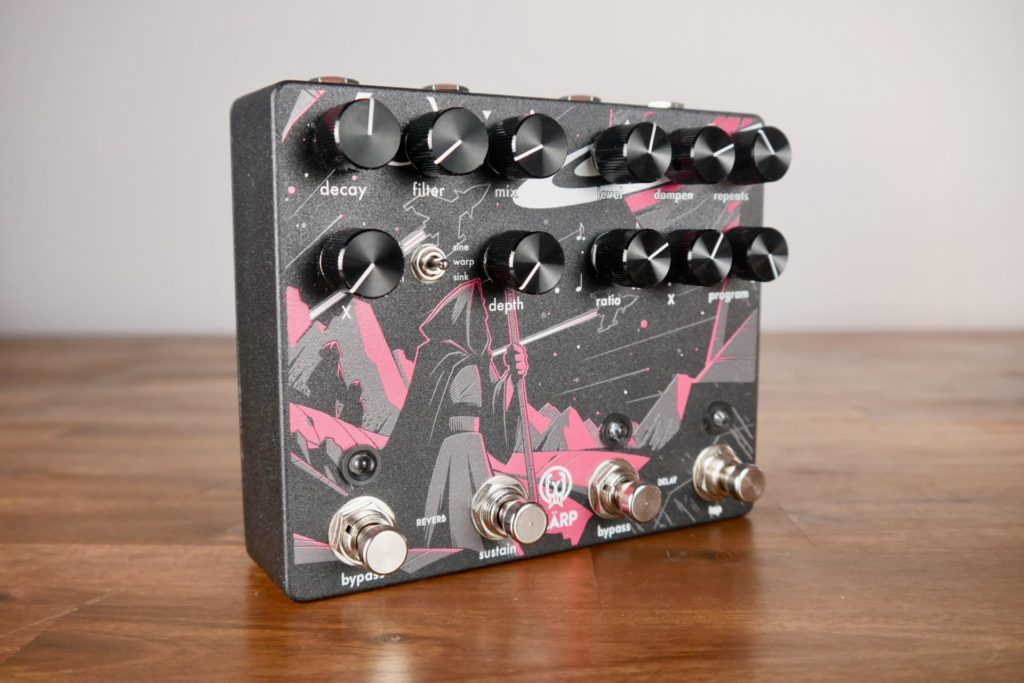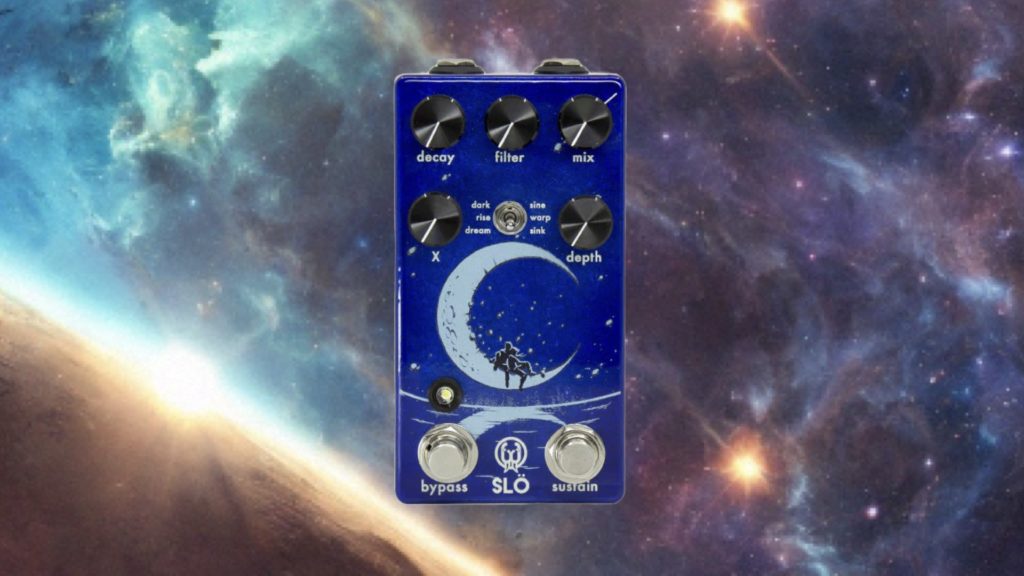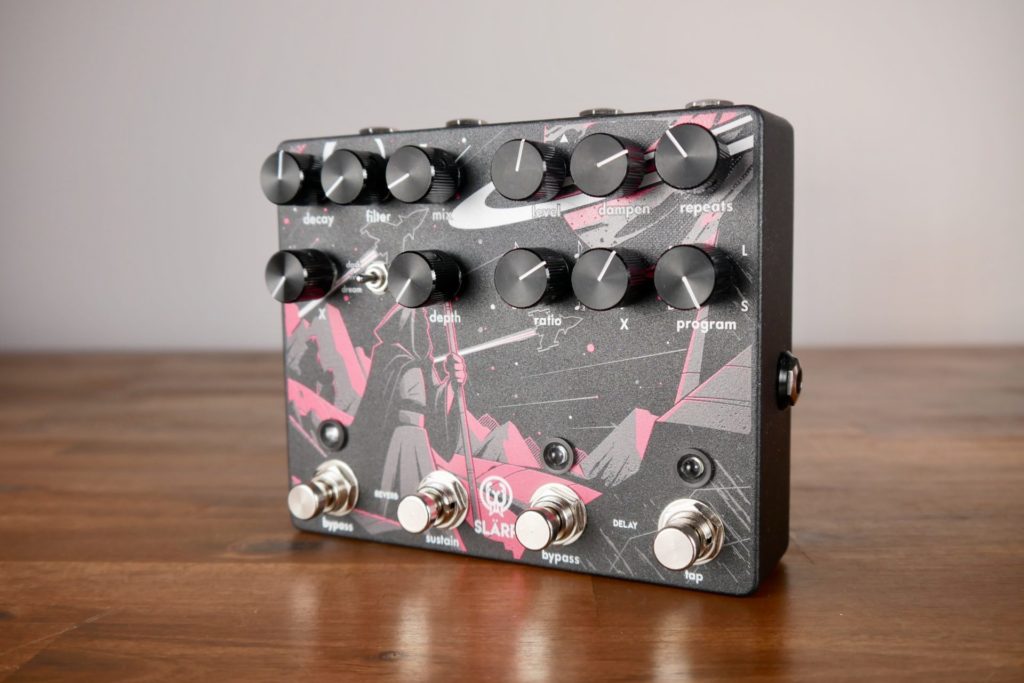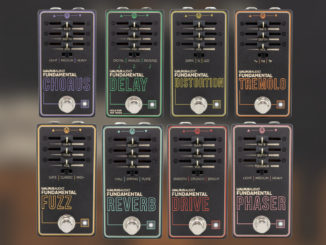This review looks closer at the Walrus Audio SLÖ in the SLÄRP, a multi-texture ambient reverb with three original algorithms with synthesizers.
Effects are wonderful tools for designing new sounds. From finalizing sounds, and adding subtle improvements to completely turning them upside down using unique effects processors like granular synthesis. Effects are often just as much fun as the actual Synthesizer itself.
Single effects or complete effects signal chains built around distortions, delays, reverbs… can give any older Synthesizer in your setup a new life and make it more interesting again for many hours, weeks, and even months. This is a reason for me to focus on more and more effects in the near future, regardless of whether hardware pedals, VST plugins, or iOS apps.
It starts with a multi-texture reverb pedal from Walrus Audio, here’s my review.
Disclaimer: Thanks to the Viennese music shop Klangfarbe.com for kindly lending me the SLÄRP (SLÖ + ARP-87) for two weeks for testing.
Walrus Audio SLÖ Review
Klangfarbe did not borrow me the SLÖ for testing but the SLÄRP. Yes, a very strange and funny name for a pedal but it has a meaning. It consists of the SLÖ reverb and the ARP-87 multi-function delay, together they form the SLÄRP.
The independent test is possible because both pedals are freely accessible. They are internally linked, but you can break the signal path by assigning the input and output cables to a single pedal. Each pedal has its own input and output making this possible. How the ARP-87 and the SLÄRP pedal sound will soon be available in their own reviews.
Walrus Audio markets the SLÖ pedal as a multi-texture reverb for ambient musicians. This could go very well with synths. Visually, no matter whether the SLÖ or SLÄRP are real eye-catchers. Both have beautiful designs that stand out. The SLÄRP is even more exciting in appearance with his space explorer on it.
The SLÖ has a mono signal path. Mono in and mono out. Less advantageous for Synthesizer players because many modern synths have a stereo out or a complete stereo path. However, the pedal is suitable for all kinds of mono synths such as the Korg monologue, Dreadbox analog synths (Hades, Erebus)…
Walrus Audio designed the pedal for guitars. There is no switch on the back where you can switch from guitar to line, as known from Eventide, which is a pity.
3 Original Algorithms
The SLÖ pedal consists of three original reverb algorithms with built-in modulation that can be conveniently selected via a switch.
- Dark – a more classy reverb with an optional lower octave reverb effect for more mysterious, gloomy timbres
- Rise – a reverb with an auto-swell effect for sparkling effects
- Dream – a large and lush ambient reverb that turns every sound, even a poop, into epic soundscapes.
I particularly like the Dark and Dream algorithm here. Dark enables nice deep sounds with a lot of body. You can create beautiful mysterious sounds. With active modulation, you can make the whole effect more organic and rich.
Dream, on the other hand, throws any sound into infinity and puts the musician on an intergalactic ambient trip. Yes, even a scream from the rubber cock.
Rise was one of the more difficult candidates. It generates nice auto-swelling reverbs that sound like bubbling in places. However, in combination with synths, it is a bit more difficult to control. I looked at some sound demos with guitars and I liked the rise algorithm better there.
It may well be that the algorithm harmonizes better with the playing style and the dynamics of a guitar. The algorithm with the synthesizer doesn’t sound bad, just not that perfect.
Hands-On Control
The operation of the pedal is very pleasing. It’s very hands-on and dispenses with menus. There are 5 parameters for direct sound tweaking, a switch as well as two footswitches. There are a few easy secondary functions: to latch the reverb, so setting it to infinity (perfect for drones), or to change the modulation speed and waveform. An LED signals the status here.
The parameters are:
- decay sets the length of the reverb tail (left short tails, right massive reverbs)
- filter is a lowpass filter that adjusts the reverb character (to have less or more harmonics)
- mix is a dry/wet mix control
- depth can adjust both the modulation amount and rate (holding down the bypass footswitch)
- X knob has different functions depending on what reverb mode you are using.
- dark: controls the lower octave sound
- rise: sets how long it takes for the swell effect to ramp up
- dream: additional vibrato effect.
Then, there is also a toggle switch with two functions. It either sets the reverb modes (dark, rise, dream) or defines the modulator waveform (sine, warp, sink).
There are also two footswitches. Of course! The first is a bypass that turns the effects on or off. Very simple. Additionally, it can also be used momentarily. So when the pedal is off you can press and hold the bypass footswitch for a quick burst of reverb. It also manages the secondary functions of the pedal.
Right next to the bypass is the sustain footswitch. It is mainly a thing in the dark and rise modes. Here you can use it to max out the reverb’s decay, perfect for looong, drony reverbs. In dream mode, it acts as a latching switch that captures and sustains. Thus, it puts any sound captures into infinity.
Presets? No, the SLÖ cannot save any parameters. With the SLÖVTA, however, Walrus Audio already has an SLÖ in the program that can save parameters and crossfade.
Video Review With Sound Demos
Summary
The Walrus Audio SLÖ is a great, lush-sounding reverb pedal. It’s clearly aimed at ambient musicians. Less for hard rockers. So a pedal for synthesizers? Yes, it is but be careful. For one, the pedal only has a mono signal path. So you can’t route every Synthesizer through it. Hoping for a stereo version so I can stereo-slööö my synthesizers.
On the other hand, the pedal is designed for guitar signals, which means that the algorithms may react differently. See my rise algorithm bits.
SLÖ is a great effect processor for quickly transporting your sounds into deep lush atmospheres. The reverb algorithms are all very high quality. Strymon or Eventide level? No, but on a very high. None of this sounds cheap or “unrealistic”. The same applies to the built quality. Knobs feel very valuable and the pedal itself also has a nice weight.
Apart from these small minus points, the Walrus Audio Slö (in the SLÄRP) is a lovely, spherical reverb. Especially ambient musicians will have great fun with it. Tip: if you want to add the SLÖ to your setup, take the SLÖTVA, which costs a bit more but has presets, etc.
Pro
- reverb sound quality
- three original algorithms
- versatility and flexibility
- hands-on interface without menu diving
- price/feature ratio
Neutral
- for my sound taste, it harmonizes better with guitars
Cons
- mono – mono signal path
- no presets, but check out the SLÖTVA, which is SLÖ with patch memory
Walrus Audio SLÖ is available now for $199/218€ and SLÖTVA for $229/248€.
More information here: Walrus Audio
Available at my partners









Be the first to comment